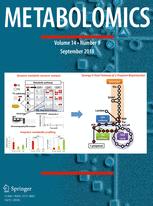Ver ítem
- xmlui.general.dspace_homeCentros e Institutos de InvestigaciónCICVyA. Centro de Investigación en Ciencias Veterinarias y AgronómicasInstituto de BiotecnologíaArtículos científicosxmlui.ArtifactBrowser.ItemViewer.trail
- Inicio
- Centros e Institutos de Investigación
- CICVyA. Centro de Investigación en Ciencias Veterinarias y Agronómicas
- Instituto de Biotecnología
- Artículos científicos
- Ver ítem
Neuronal network analyses reveal novel associations between volatile organic compounds and sensory properties of tomato fruits
Resumen
Introduction The process of tomato (Solanum lycopersicum) breeding has affected negatively the fruit organoleptic properties and this is evident when comparing modern cultivars with heirloom varieties. Flavor of tomato fruit is determined by a complex combination of volatile and nonvolatile metabolites that is not yet understood.
Objectives The aim of this work was to provide an alternative approach to exploring the relationship between tomato odour/
[ver mas...]
Introduction The process of tomato (Solanum lycopersicum) breeding has affected negatively the fruit organoleptic properties and this is evident when comparing modern cultivars with heirloom varieties. Flavor of tomato fruit is determined by a complex combination of volatile and nonvolatile metabolites that is not yet understood.
Objectives The aim of this work was to provide an alternative approach to exploring the relationship between tomato odour/ taste and volatile organic compounds (VOCs).
Methods VOC composition and organoleptic properties of seven Andean tomato landraces along with an edible wild species (Solanum pimpinellifolium) and four commercial varieties were characterized. Six hedonic traits were analyzed by a semitrained sensory panel to describe the organoleptic properties. Ninety-four VOCs were analyzed by headspace solid phase microextraction/gas chromatography–mass spectrometry (HS/SPME/GC–MS). The relationship between sensory data and VOCs was explored using an Artificial Neural Networks model (Kohonen Self Organizing Maps, omeSOM).
Results and Conclusion The results showed a strong preference by panelists for tomatoes of landraces than for commercial varieties and wild species. The predictive analysis by omeSOM showed 15 VOCs significantly associated to the typical and atypical tomato odour and taste. Moreover, omeSOM was used to predict the relationship of VOC ratios with sensory data.
A total of 108 VOC ratios out of 8837 VOC ratios were predicted to be contributing to the typical and atypical tomato odour and taste. The metabolic origin of these flavor-associated VOCs and the metabolic point or target for breeding strategies were discussed.
[Cerrar]

Autor
Cortina, Pablo Ramiro;
Santiago, Ana N.;
Sance, María M.;
Peralta, Iris Edith;
Carrari, Fernando;
Asis, Ramón;
Fuente
Metabolomics 14: 57 (Mayo 2018)
Fecha
2018-05
Editorial
Springer
ISSN
1573-3890
1573-3882
1573-3882
Formato
pdf
Tipo de documento
artículo
Palabras Claves
Derechos de acceso
Restringido
 Excepto donde se diga explicitamente, este item se publica bajo la siguiente descripción: Creative Commons Attribution-NonCommercial-ShareAlike 2.5 Unported (CC BY-NC-SA 2.5)
Excepto donde se diga explicitamente, este item se publica bajo la siguiente descripción: Creative Commons Attribution-NonCommercial-ShareAlike 2.5 Unported (CC BY-NC-SA 2.5)

